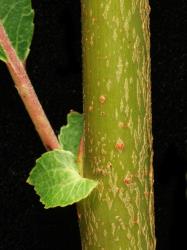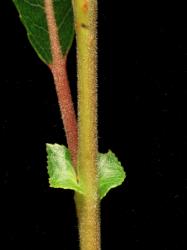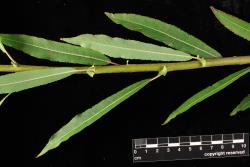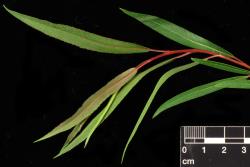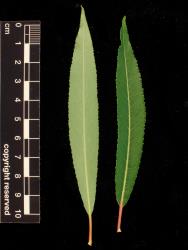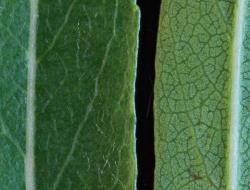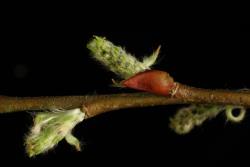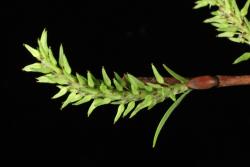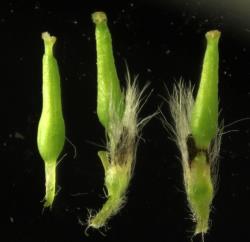Current year's branchlets moderately densely velvety, not persisting, glabrous, olive-green, tinted slightly pink. Flower buds 7–8 mm long, 3 mm wide, with two lateral angles, mid-brown (UCL58), glabrous. Leaves alternate. Stipule persistent, 7 mm long, ovate. Petiole 9–18 mm long, densely tomentose on the upper surface, glands absent, pinky red, the base not enlarged. Emerging leaves green, with sparse, long, wispy hairs that do not persist. Proximal leaves entire or incompletely and sparsely serrate. Leaf lamina 87–122 mm long, 10–24 mm wide, length to width ratio 5.5–9.7:1, very narrowly elliptical, not falcate; base cuneate; apex very narrowly acute; leaf galls absent; margins densely serrulate, plane; upper lamina surface midvein raised, glabrous or sparsely hairy, stomata absent from upper surface; lower lamina surface midvein and side-veins raised, indistinctly glaucous, glabrous. Catkins emerging coetaneously with leaves. Flowering branch 24–38 mm long, with 4 leaves. Female catkin 31 mm long, 4 mm diameter; catkin rachis not visible between flowers. Flower bracts 2.0 mm long, 0.5 mm wide, bicoloured, flat; apex rounded, long-silky hairs on both surfaces and margins. Female nectary 1, 0.5 mm long, 0.22 mm wide; ovary 2.0 mm long, glabrous; stipe 0.4–0.6 mm long, extending to 1.8 mm after fertilisation of the ovary; style base 0.6 mm long, style arms 0.2 mm long, unlobed, stigmas red.
Current year branchlets are red and glabrous. Year-old branchlets are olive-green. Leaves are very narrowly elliptical, almost glabrous, dull on both surfaces, and weakly glaucous below. Stipules are obvious and persistent on summer growth. Stomata are absent from the upper leaf surface. Ovary and capsule are both glabrous, with a stipe about 0.4–0.5 mm long (elongating to 1.5 mm long) and a style base 0.4–0.5 mm long, style arms 0.1–0.2 mm long. The stigmatic surfaces of the short style arms are crimson and the ovary may be crimson tinted.
Dorn (1995) commented on S. eriocephala var. eriocephala, "This variety occasionally hybridizes with S. petiolaris and S. sericea where they grow together. The hybrid with S. petiolaris has narrower leaves with fewer teeth, often some ferruginous hairs on the very young leaves, the capsules tend to be longer with conspicuous beaks and often have some hairs, the stipes tend to be longer, and the flower bracts are darker, wider, and less pubescent."
This hybrid resembles Salix purpurea in its leaves and young branchlets, being almost glabrous and with a dull upper surface. Young branchlets are similar to those of S. purpurea in being red and glabrous. The mature leaves of S. eriocephala × S. petiolaris differ from those of S. purpurea in being densely serrate on all margins (in S. purpurea the margins are entire or partly toothed). The ovaries of S. eriocephala × S. petiolaris are glabrous and are on a stalk 0.6–1.5 mm long, so are neither S. purpurea (which has sessile ovaries) nor S. petiolaris (which has hairy ovaries).
This hybrid most resembles Salix eriocephala, but the leaves of S. eriocephala × S. petiolaris are narrower (10–24 mm versus 31–43 mm wide in S. eriocephala). The leaves of S. eriocephala × S. petiolaris are almost glabrous, whereas in S. eriocephala the young leaves are moderately densely tomentose and mature leaves retain some hairs.
Naturalised in Canterbury (Craigieburn Stream 1987). In cultivation in the Southern North Island (Aokautere and Massey University), Canterbury (Coutts Island 1980).
Planted in Craigieburn Stream and collected wild there in 1987. In cultivation in Palmerston North as PN715 and PN716. Collected in 1980 from the Waimakariri River stopbank near Coutts Island, presumably planted there.
First collection: CHR 372292, W.R. Sykes 122/80, 24 September 1980, Waimakariri River stopbank near Coutts Island.
First publication: This publication.
Flowering: Early September.
Ploidy unknown but flow cytometry provisionally indicates that PN716 is diploid (2n = 38).
Plants present in New Zealand are Salix eriocephala × S. petiolaris in the opinion of Yulia Kuzovkina (pers. comm., September 2018), who has seen images of PN715 and PN716. The description is based on PN716 and Sykes 122/80, CHR 477887). PN715 and PN716 are possibly the same clone.
The parent species Salix petiolaris Sm. was published in Trans. Linn. Soc. London 6: 122–123 (1802).



